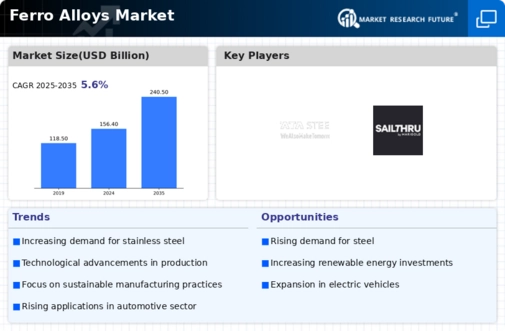Top Industry Leaders in the Ferro Alloys Market

The global Ferro Alloys market is a dynamic landscape sculpted by fierce competition, evolving trends, and the ever-hungry iron and steel industry. Understanding this terrain is crucial for any player, and this comprehensive analysis dives deep into the market's competitive ecosystem, recent developments, and strategies for conquering the share.
List of Strategies Adopted:
-
Product Diversification: Leading players like Vale S.A. and Jindal Group are expanding their portfolios beyond traditional ferroalloys to niche products like ultra-low carbon ferrochrome and rare earth alloys, catering to the growing demand for high-performance steels. -
Technological Advancements: Automation, energy efficiency initiatives, and investments in sustainable production processes are being prioritized to reduce costs, improve quality, and comply with stricter environmental regulations. ArcelorMittal's HIsarna plant in India is a prime example of such advancements. -
Geographic Expansion: Emerging markets like China and India are witnessing booming steel production, attracting major players like Glencore and Brahm Group to establish production facilities and distribution networks in these regions. -
Mergers and Acquisitions: Consolidation through acquisitions and strategic partnerships is reshaping the market. S.C. Ferl S.R.L.'s recent acquisition of Tinfos Finland bolsters its manganese alloy footprint, while OFZ S.A.'s partnership with Tsingshan Group unlocks access to Chinese resources. -
Vertical Integration: Players like Pertama Ferroalloys are integrating backward by venturing into chrome and manganese mining, securing raw material supply and mitigating price volatility.
Factors for Market Share:
-
Cost Competitiveness: Efficient production processes, access to low-cost raw materials, and strategic sourcing partnerships play a crucial role in determining who takes the lion's share. -
Product Quality and Consistency: Stringent quality standards and consistent product performance are essential for building trust with steelmakers and securing long-term contracts. -
Customer Service and Logistics: Providing efficient logistical support, technical expertise, and timely delivery strengthens customer relationships and loyalty. -
Sustainability Initiatives: The increasing focus on green steel production is pushing companies to adopt eco-friendly practices, with low-carbon and recycled-content ferroalloys becoming a market differentiator. -
Government Regulations and Trade Policies: Trade restrictions, environmental regulations, and government subsidies can significantly impact market dynamics and influence player strategies.
Key Companies in the ferro alloys market includes
-
Shanghai Ferroalloys Works (China),
-
Georgian American Alloys (USA),
-
Gulf Ferroalloys Company (SABAYEK) (Saudi Arabia),
-
Tata Steel (India),
-
Brahm Group (India),
-
Ferroalloy Corporation Limited (India),
-
China Minmetals Corporation (China),
-
Pertama Ferroalloys Sdn. Bhd. (Malaysia),
-
SAIL (India),
-
OFZ, a.s (Slovakia)
Recent Developments:
August 2023: Glencore announces plans to expand its ferrochrome production capacity in South Africa by 20%, aiming to capitalize on the anticipated rise in stainless steel demand.
September 2023: The European Union imposes anti-dumping duties on ferrosilicon imports from China, providing relief to European producers but likely affecting downstream steel prices.
December 2023: The International Manganese Institute forecasts a modest growth in global manganese consumption, potentially leading to higher ferro-manganese prices in the coming months.

